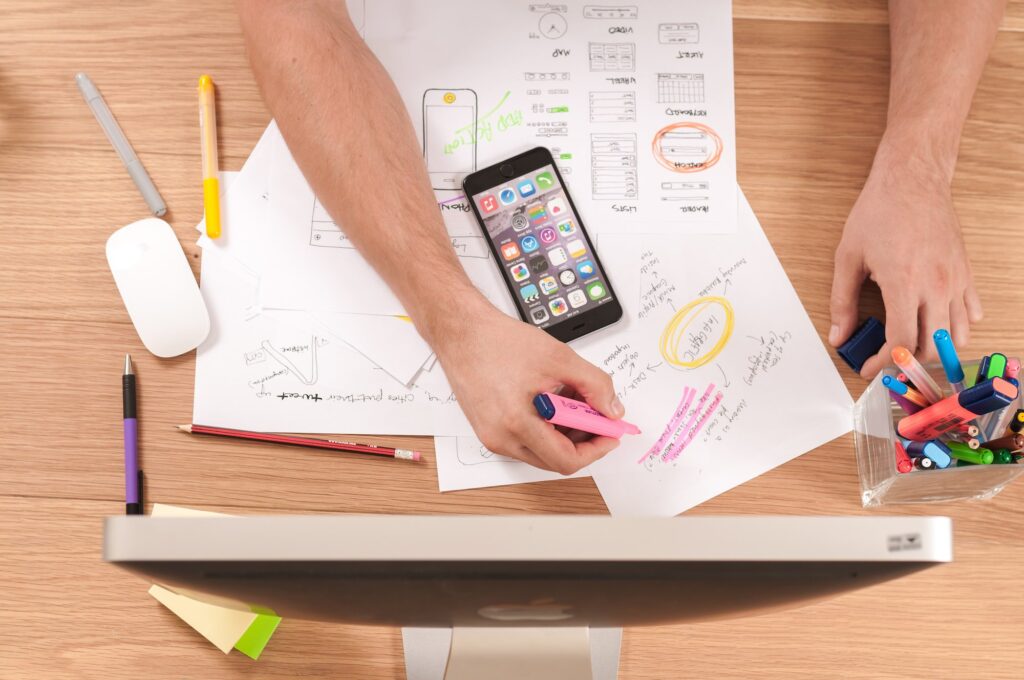Have you ever tried to piece together a complex puzzle, without the guiding image on the box? Designing process steps can often feel just like that – an intricate enigma with no clear starting point.
Designing Process Steps: Your Roadmap to Creative Mastery
I recall being faced with such a design challenge. I was staring at this mountain of ideas and concepts for our next big project, feeling overwhelmed. The goal seemed distant; my team looked at me expectantly.
“Where do we start?” They asked, their faces mirroring my own confusion.
The answer wasn’t easy then. But through trial and error, deep dives into user needs and countless brainstorming sessions later – we learned to master it!
We’ve uncovered something pretty incredible. Empathizing helps us uncover the true problems users are facing. Defining these issues brings order to the chaos and gives us a clear focus. Then, through ideation, we spark innovative solutions that can really change things up! Prototyping lets us bring those ideas into reality, make them something you can touch and see. And finally, testing isn’t just about finding faults or glitches—it’s our chance to confirm if we’re on track.
Table of Contents:
- The Essence of the Design Process
- An Overview of The Methodology
- The Power Behind Problem-Solving
- Tackling Complexity
- Empathize Phase in Design Thinking
- Why Empathy Matters
- User Research: The Heart of Empathy
- Tech Tools for Gathering Insights
- Avoid Assumption Traps
- The Bottom Line?
- Innovative Solutions Begin with Empathy
- Define Phase in Design Thinking
- Crafting a Clear Problem Statement
- Setting Specific Features and Objectives
- Design Thinking: A Real-World Application
- Ideate Phase in Design Thinking
- Techniques for Brainstorming and Idea Generation
- Encouraging Creativity and Out-of-the-box Thinking
- Evaluating Promising Ideas
- The Human Element in Ideation
- Prototype Phase in Design Thinking
- The Role of Prototyping in The Design Process
- Different Types of Prototypes
- Test Phase in Design Thinking
- Incorporating User Feedback into Design Iteration
- Identifying Areas of Improvement
- The Iterative Nature of the Design Process
- Incorporating Feedback from Multiple Sources
- Finding Balance Between User Needs And Technical Constraints
- Navigating The Stages Of Design Thinking
- Applying Design Thinking to Complex Problems
- Tackling Complexity with Empathy and Creativity
- Finding Innovative Solutions through Ideation
- Testing Ideas with Real Users
- A Methodology Designed for Complex Challenges
- Conclusion

The Essence of the Design Process
Understanding the design process is a lot like assembling an intricate puzzle. Each piece, or step, contributes to creating an innovative solution that addresses complex problems effectively.
Designing is not merely about aesthetics; it’s a strategic and systematic approach used to solve problems. A well-executed design process provides solutions that are both functional and visually appealing, all while considering user needs at every stage.
This systematic approach breaks down large projects into manageable chunks—a bit like how you’d tackle making dinner for a big group. This makes solving even the most daunting challenges possible by tackling them one step at a time. You can think of this as breaking down your cooking project into different tasks: gathering ingredients (empathize phase), deciding on recipes (define phase), coming up with alternatives if something isn’t available (ideate phase), preparing each dish (prototype phase) before finally presenting it to guests for their feedback and enjoyment (testing).
An Overview of The Methodology
A central part of this creative journey is design thinking methodology. It’s akin to following GPS navigation – giving direction through uncharted territory using iterative cycles instead of going in blindfolded.
Key components include understanding real users’ issues deeply, brainstorming alternative solutions collaboratively during ideation sessions—kinda like throwing spaghetti against the wall and seeing what sticks—and then testing those ideas thoroughly. Feedback from these tests helps refine our ‘recipe’, ensuring we create solution designs tailored specifically towards user needs.
The Power Behind Problem-Solving
Solution-based approaches, a central tenet of the design process, allows us to turn problems into opportunities. It’s like seeing a weed-infested garden not as an eyesore but as fertile ground for fresh growth.
It provides ways to challenge assumptions and question the status quo by placing users at its core—think user-centric rather than designer-driven.
Tackling Complexity
It’s remarkable to witness and certainly deserves admiration. It’s fascinating to observe and definitely worth appreciating.
Key Thought:
needs and desires. It’s a road map that lets us navigate the complexities of any project, no matter how big or small. Each step is like a piece in an intricate puzzle, working together to build innovative solutions—not just aesthetically pleasing ones. This approach makes daunting tasks manageable, much like cooking for a crowd by preparing one dish at a time. So, whether you’re venturing into uncharted territory or looking to tackle grand challenges, remember—design thinking can guide your way.
Empathize Phase in Design Thinking
The first step of the design thinking process, often referred to as the empathize phase, is crucial. It’s all about gaining a deep understanding of users’ needs and experiences. But why does empathy matter so much in the design process?
Why Empathy Matters
In this stage, designers are tasked with stepping into their users’ shoes. This enables them to comprehend not just what their users require from a product or service, but additionally why those needs exist. Understanding these nuances can lead to innovative solutions that genuinely resonate with real users.
According to d.school’s Introduction to Design Thinking PROCESS GUIDE, one major goal here is challenging assumptions and uncovering hidden user needs that might otherwise be overlooked.
User Research: The Heart of Empathy
To gain deeper insights into your audience’s perspectives during this stage, conducting thorough user research is key. We’re talking interviews, surveys – anything that lets you peek behind the curtain at your audience’s genuine thoughts and feelings regarding their problems.
Tech Tools for Gathering Insights
Luckily there are many tools out there designed specifically for gathering such data; think eye-tracking software or heat map generators like Hotjar for digital products or observational studies for physical ones.
Avoid Assumption Traps.
Beware though – while it may seem easier to rely on existing knowledge or assumptions about what your target market wants or thinks – don’t fall into this trap. As mentioned earlier by d.school, an essential part of empathizing successfully involves challenging our own biases and preconceptions.
The Bottom Line?
As the first step in a human-centered design process, empathy isn’t just about sympathy. It’s about using direct observation and engagement to gain a deep understanding of users’ problems and needs. This can then be used as solid ground from which to start generating solutions.
Innovative Solutions Begin with Empathy
setting a strong base in the empathize phase. It’s key to building a deep understanding and fostering real connections.
Key Thought:
Understanding your users’ needs and experiences is the cornerstone of design thinking. This initial phase, often called the ’empathize phase’, can spark innovative solutions that truly connect with real-world users. It encourages us to challenge our assumptions and uncover hidden needs by stepping into their shoes. We gather these insights through user research methods like interviews and surveys, enhanced by cutting-edge tech tools such as eye-tracking software or heat maps.
Define Phase in Design Thinking
The Define phase is a critical step in the design thinking process. It’s here where designers craft clear problem statements and set specific features for their projects.
Crafting a Clear Problem Statement
A well-crafted problem statement aligns with user needs, making it essential to this phase. Creating such a statement can be likened to piecing together an intricate puzzle – you’re essentially gathering insights from real users’ problems and framing them into actionable challenge statements.
To make sure your team has nailed down the right issue, question everything. Is it truly a problem? For whom? Why does it matter?
These questions help us dig deeper into the problem space, leading us towards more innovative solutions.
Setting Specific Features and Objectives
In setting project objectives or defining specific features for our solution, we again turn to our users – they are at the heart of human-centered design after all.
This task could be seen as designing an interactive map; each feature representing landmarks that guide users on their journey through your product or service.
Herbert Simon’s The Sciences of Artificial, delves deeply into this aspect.
Let’s take creating user personas as an example: We get these by conducting interviews with potential users about their experiences relating to our product domain.
Through these conversations, we identify patterns and trends that inform persona creation – fictitious but grounded representations of segments within our target audience.
From there, priorities are assigned based on those identified needs—what aspects need immediate attention versus what could come later?
This process, although complex and at times challenging, is critical in ensuring the project aligns with user needs.

Design Thinking: A Real-World Application
A great example of defining phase application is Airbnb’s redesign a few years back. They had to redefine their problem statement after gathering feedback from real users.
I’m sorry, but there’s no content provided for me to rewrite. Could you please provide the paragraph that needs to be revised?
Key Thought:
Defining in design thinking is critical. It’s like being a puzzle solver, shaping user insights into actionable challenges. This phase involves questioning everything and crafting clear problem statements that match with what users need. It’s about setting specific features for your project—kind of like designing an interactive map—to guide users on their journey through your product or service. Yes, the process might seem complex, but it plays a crucial role in making sure everything lines up just right.
Ideate Phase in Design Thinking
When it comes to the ideate phase of design thinking, think about it as your chance to let your creativity fly. It’s a brainstorming session on steroids, where no idea is too wild or absurd.
Techniques for Brainstorming and Idea Generation
The ideation stage is more than just spewing out ideas. We use specific techniques that help us generate innovative solutions and challenge assumptions. For example, ‘worst idea’ sessions can lead to surprisingly feasible designs by reversing our typical way of thinking.
We also apply other design thinking methodologies, such as mind maps and SCAMPER (Substitute, Combine, Adapt, Modify/Magnify/Minify/, Put to Other Uses,Eliminate/Rearrange) technique which push us beyond traditional boundaries.
Encouraging Creativity and Out-of-the-box Thinking
Creativity isn’t something innate – it’s an activity that needs to be done habitually. To flex this muscle during the ideation phase we create an open environment that encourages team members not only express their ideas but build upon others’. This collaborative process often results in unique perspectives emerging from different backgrounds within our diverse team.
Evaluating Promising Ideas
All ideas are good at this point — remember we’re looking for quantity over quality here — but some will inevitably stand out more than others. That’s why evaluating promising concepts becomes crucial before moving onto prototyping. To do so effectively requires understanding both problem space well enough so we can identify potential pitfalls early while also considering users’ needs throughout each decision-making step.
Ultimately, the ideate phase is a vibrant part of the design process. It’s where we get to put on our thinking caps and dream up solutions that are both innovative and practical for real users.
The Human Element in Ideation
We recall that a person, with their distinct requirements, wants and backgrounds, is always the focal point of each plan we make.
Key Thought:
So, go ahead and flex your creativity muscle. Dive headfirst into ‘worst idea’ sessions, create mind maps, or use SCAMPER to shake things up. Because remember—innovation comes when we challenge the norms. So make sure you’re fostering an environment where everyone feels free to share their ideas.
Prototype Phase in Design Thinking
The prototype phase is the ‘show and tell’ stage of the design thinking process. It’s where ideas transform into tangible forms, ready for user testing.
The Role of Prototyping in The Design Process
Prototypes are simplified versions of your product or solution. They’re built to let you see how your concept works when faced with real users. You don’t need a perfect version at this point; just something that can help gather feedback.
It’s like making a model airplane before building the actual aircraft: it gives you an idea about aerodynamics without having to build and crash several full-sized planes. But remember, prototyping isn’t just limited to physical products—it’s also crucial when designing digital solutions.
Different Types of Prototypes
You might be surprised by what counts as a prototype – anything from rough sketches on paper, storyboards, 3D models made out of clay or foam board, wireframes for websites or even role-play scenarios can serve as prototypes depending upon what questions they aim to answer.
A good rule here is not investing too much time creating detailed designs yet because they’re likely going to change based on user feedback anyway.
Paper Prototypes
This method uses simple materials like paper and pens. For example, if we’re talking about app design development process, each screen could be drawn separately then stacked together so users can flip through them simulating interaction flow between different screens. Nielsen Norman Group suggests these type as one way beginners learn design principles practically while keeping costs low.
Digital Mock-ups & Wireframes
If your project is digital, you might use tools like Adobe XD or Sketch to create interactive mock-ups. These are often more polished and can simulate the feel of a final product better than paper prototypes.
Physical Models
Got a physical product as your solution? You can create an excellent tangible prototype to test. Consider 3D printing or simply crafting it from materials around your house.
Key Thought:
Sketch, prototypes are vital in understanding user needs. They act as a bridge between your concept and its interaction with real users. From paper crafts to digital mock-ups created using tools like Adobe XD or Sketch, they offer invaluable insights by gathering user feedback.
Test Phase in Design Thinking
The test phase, a crucial stage in the design thinking process, is where real users get their hands on your prototype. It’s here that you gather feedback and identify areas of improvement.
Incorporating User Feedback into Design Iteration
User testing plays an integral role at this juncture. As we let our creation loose for users to explore, it becomes less about what we think works and more about how they interact with it.
Analyzing user feedback can sometimes feel like finding your way through a maze blindfolded. But remember: even negative feedback provides valuable insights into what needs fixing or improving.
A key aspect of this step is usability studies – these give us firsthand insight into any hurdles our users face while interacting with the product. Nielsen Norman Group offers some great resources on conducting effective usability studies.
Identifying Areas of Improvement
This part involves taking those lessons from user testing and translating them back into design iterations – kind of like having your cake (the prototype) and eating it too (improving upon it).
We have to ensure every detail serves its purpose efficiently without hindering other aspects; if not, adjustments are needed. It’s as simple as that.
Sometimes though, figuring out exactly what requires tweaking can be challenging. BUT WAIT., there’s no need to panic—Tubik Studio suggests, “Less is more”. In design, this means a clean and simple interface often leads to better user experience.
Now that we’ve walked through the test phase in Design Thinking let’s look at how it fits into the overall process. IDEOU offers an excellent course on applying Design Thinking effectively. Give it a try.
The Iterative Nature of the Design Process
Think about designing a product like trying to perfect a recipe. You wouldn’t just make it once and then serve it in your restaurant, right? No. Just like refining that secret sauce, design thinking is an iterative process.
You’re constantly tweaking ingredients (or design elements), testing them out on real users (your diners), gathering feedback, making changes based on that feedback, and then serving up another iteration. It’s this constant cycle of refinement which helps us strike balance between user needs and technical constraints – much like finding harmony between flavor profiles in our hypothetical dish.
Incorporating Feedback from Multiple Sources
“An excessive number of people involved can lead to disaster.” But when we talk about design development processes, having multiple sources of input can be beneficial.
Gathering diverse perspectives not only uncovers flaws you might have missed but also brings fresh ideas to light. Whether these insights come from team members during brainstorming sessions or end-users providing invaluable critique during prototype tests – every bit contributes towards crafting more effective solutions.
Finding Balance Between User Needs And Technical Constraints
A designer’s job isn’t as simple as slapping together some pretty graphics. They need to juggle aesthetics with functionality while keeping technical limitations into account too – kind of like cooking gourmet food over a campfire.
To get things done within these bounds without compromising usability requires regular touchpoints with developers for understanding feasible designs along with relentless user testing for validating their effectiveness.

Navigating The Stages Of Design Thinking
- Ideation: Like a chef experimenting with ingredients, this stage is all about letting your creativity run wild. Go for the bizarre.
- Prototype: Here we create a mock-up of our product (the test dish) for real users to interact with.
- User Testing: Think of it like taste testers trying out a meal and giving their thoughts. We use this feedback to make the necessary tweaks before we let everything go live.
Key Thought:
the final dish that’s the product. The right mix of ideation, prototyping, and user testing is key. These are not just stages in design thinking but ingredients to cook up a product that meets user needs while respecting technical constraints. Constant interaction with developers and persistent feedback from diverse sources let us perfect our recipe for success.
Applying Design Thinking to Complex Problems
The design thinking process consists of an empathetic, human-centered approach that aims to solve complex problems in innovative ways. Let’s explore how this methodology can help create solution-based approaches for your next project.
Tackling Complexity with Empathy and Creativity
Utilizing empathy as the basis of problem-solving can yield powerful results. It’s the starting point of any effective design thinking model because it helps us gain insights into real users’ problems and experiences. By deeply understanding their needs and desires, we’re better equipped to define clear problem statements that accurately represent our users’ challenges.
This process also encourages us to challenge assumptions about what solutions might look like or how they should function. By questioning these preconceived notions, we often discover new perspectives that lead towards more effective alternatives.
Finding Innovative Solutions through Ideation
The ideation phase brings together team members for brainstorming sessions aimed at generating ideas from various viewpoints. This stage thrives on diversity – not just in terms of team composition but also in thought processes and backgrounds – resulting in richer idea generation.
A range of ideation techniques can be used during this phase: mind mapping, worst idea (to encourage free-flowing thoughts), role-playing scenarios etc., each serving different purposes but all aiming at exploring wide solution spaces within the defined problem area.
Testing Ideas with Real Users
We move forward by taking promising concepts identified during ideation into prototype test phases where real users interact with early versions of proposed solutions – providing crucial feedback which fuels iterative cycles of refinement until a feasible design emerges as a strong candidate for implementation.
But user testing doesn’t end with prototyping. It continues into the final stages of design development process, and even beyond product launch. We always strive to gather feedback, learn from it, and apply our insights to future iterations – an approach known as the iterative process or cycle of learning.
A Methodology Designed for Complex Challenges
Speaking about strength, it’s an essential quality we all need. Whether physical or emotional, strength helps us overcome challenges and keep pushing forward.
Key Thought:
Design thinking is a powerful tool for solving complex problems. It starts with empathy, understanding users’ needs and desires to define clear problem statements. Challenging assumptions opens the door to innovative solutions, spurred on by diverse ideation techniques. Testing ideas with real users ensures that proposed designs are refined until feasible options emerge. This iterative process doesn’t stop at product launch; it’s an ongoing journey of improvement and innovation.
Conclusion
Designing process steps doesn’t have to feel like a daunting task. Remind yourself that the whole can be conquered by dealing with its individual components.
Start by empathizing with your users. It’s crucial in understanding their needs and challenges. This knowledge then guides you as you define clear problem statements and set specific project features.
The ideation phase is where creativity shines! Let innovative solutions flow freely before moving onto prototyping – bringing ideas to life while considering feasibility.
User testing isn’t just for spotting errors, but confirming if we’re on track. Then refine designs based on feedback from multiple sources – that’s the iterative nature of design thinking!
In essence, designing process steps equips us to solve complex problems effectively and efficiently. You’ve got this.




